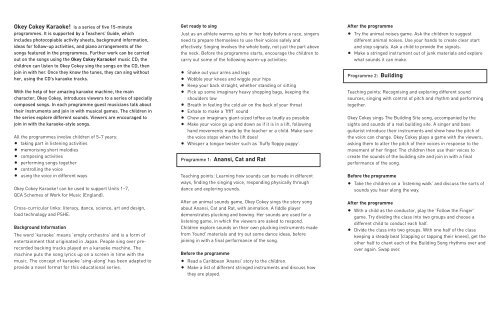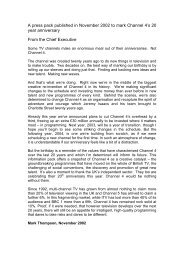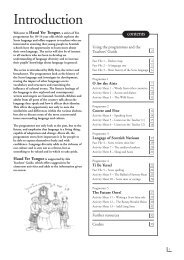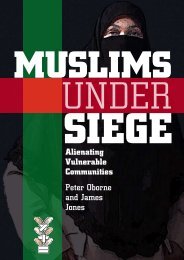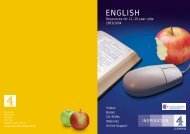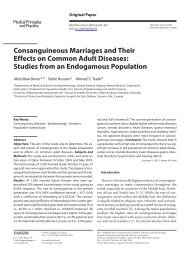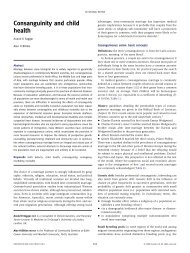Star maths 1 INSERT GOOD - Channel 4
Star maths 1 INSERT GOOD - Channel 4
Star maths 1 INSERT GOOD - Channel 4
Create successful ePaper yourself
Turn your PDF publications into a flip-book with our unique Google optimized e-Paper software.
Okey Cokey Karaoke! is a series of five 15-minute<br />
programmes. It is supported by a Teachers’ Guide, which<br />
includes photocopiable activity sheets, background information,<br />
ideas for follow-up activities, and piano arrangements of the<br />
songs featured in the programmes. Further work can be carried<br />
out on the songs using the Okey Cokey Karaoke! music CD; the<br />
children can listen to Okey Cokey sing the songs on the CD, then<br />
join in with her. Once they know the tunes, they can sing without<br />
her, using the CD’s karaoke tracks.<br />
With the help of her amazing karaoke machine, the main<br />
character, Okey Cokey, introduces viewers to a series of specially<br />
composed songs. In each programme guest musicians talk about<br />
their instruments and join in with musical games. The children in<br />
the series explore different sounds. Viewers are encouraged to<br />
join in with the karaoke-style songs.<br />
All the programmes involve children of 5–7 years:<br />
• taking part in listening activities<br />
• memorising short melodies<br />
• composing activities<br />
• performing songs together<br />
• controlling the voice<br />
• using the voice in different ways<br />
Okey Cokey Karaoke! can be used to support Units 1–7,<br />
QCA Schemes of Work for Music (England).<br />
Cross-curricular links: literacy, dance, science, art and design,<br />
food technology and PSHE.<br />
Background Information<br />
The word ‘karaoke’ means ‘empty orchestra’ and is a form of<br />
entertainment that originated in Japan. People sing over prerecorded<br />
backing tracks played on a karaoke machine. The<br />
machine puts the song lyrics up on a screen in time with the<br />
music. The concept of karaoke 'sing-along' has been adapted to<br />
provide a novel format for this educational series.<br />
Get ready to sing<br />
Just as an athlete warms up his or her body before a race, singers<br />
need to prepare themselves to use their voices safely and<br />
effectively. Singing involves the whole body, not just the part above<br />
the neck. Before the programme starts, encourage the children to<br />
carry out some of the following warm-up activities:<br />
• Shake out your arms and legs<br />
• Wobble your knees and wiggle your hips<br />
• Keep your back straight, whether standing or sitting<br />
• Pick up some imaginary heavy shopping bags, keeping the<br />
shoulders low<br />
• Breath in feeling the cold air on the back of your throat<br />
• Exhale to make a ‘fffff’ sound<br />
• Chew an imaginary giant-sized toffee as loudly as possible<br />
• Make your voice go up and down as if it is in a lift, following<br />
hand movements made by the teacher or a child. Make sure<br />
the voice stops when the lift does!<br />
• Whisper a tongue twister such as ‘fluffy floppy puppy’.<br />
Programme 1: Anansi, Cat and Rat<br />
Teaching points: Learning how sounds can be made in different<br />
ways, finding the singing voice, responding physically through<br />
dance and exploring sounds.<br />
After an animal sounds game, Okey Cokey sings the story song<br />
about Anansi, Cat and Rat, with animation. A fiddle player<br />
demonstrates plucking and bowing. Her sounds are used for a<br />
listening game, in which the viewers are asked to respond.<br />
Children explore sounds on their own plucking instruments made<br />
from 'found' materials and try out some dance ideas, before<br />
joining in with a final performance of the song.<br />
Before the programme<br />
• Read a Caribbean ‘Anansi’ story to the children.<br />
• Make a list of different stringed instruments and discuss how<br />
they are played.<br />
After the programme<br />
• Try the animal noises game. Ask the children to suggest<br />
different animal noises. Use your hands to create clear start<br />
and stop signals. Ask a child to provide the signals.<br />
• Make a stringed instrument out of junk materials and explore<br />
what sounds it can make.<br />
Programme 2: Building<br />
Teaching points: Recognising and exploring different sound<br />
sources, singing with control of pitch and rhythm and performing<br />
together.<br />
Okey Cokey sings The Building Site song, accompanied by the<br />
sights and sounds of a real building site. A singer and bass<br />
guitarist introduce their instruments and show how the pitch of<br />
the voice can change. Okey Cokey plays a game with the viewers,<br />
asking them to alter the pitch of their voices in response to the<br />
movement of her finger. The children then use their voices to<br />
create the sounds of the building site and join in with a final<br />
performance of the song.<br />
Before the programme<br />
• Take the children on a ‘listening walk’ and discuss the sorts of<br />
sounds you hear along the way.<br />
After the programme<br />
• With a child as the conductor, play the 'Follow the Finger'<br />
game. Try dividing the class into two groups and choose a<br />
different child to conduct each half.<br />
• Divide the class into two groups. With one half of the class<br />
keeping a steady beat (clapping or tapping their knees), get the<br />
other half to chant each of the Building Song rhythms over and<br />
over again. Swap over.
Programme 3: The Raja with Big Ears<br />
Teaching points: Singing with control of dynamics, learning how<br />
the musical elements can be used expressively and exploring the<br />
difference between beat and rhythm.<br />
Shadow puppets act out the words of the song as Okey Cokey sings.<br />
She then shows viewers how to clap the rhythm of some of the<br />
words, getting louder each time. A tabla player demonstrates how<br />
his drums are played and shows how the children's names can be<br />
played as rhythms. The children practise making echoes and join in<br />
with the final performance of the song, The Raja with Big Ears.<br />
Before the programme<br />
• Play a game of Chinese whispers. Has the message changed<br />
by the time it reaches the last person?<br />
• Talk about echoes. Some children might have heard echoed<br />
sounds under a bridge or in a cave.<br />
After the programme<br />
• Play the echo game. The leader plays the phrase loudly and<br />
the rest of the class have to play it back quietly three times.<br />
Try this game with words and phrases, body percussion and<br />
classroom instruments.<br />
Programme 4: Toys<br />
Teaching points: Using the voice in different ways, performing<br />
short rhythmic patterns, organising sounds and developing<br />
musical ideas.<br />
Okey Cokey plays a toys sound game before singing the Toys song.<br />
The children use percussion instruments to illustrate a story<br />
about toys. Okey Cokey asks the viewers to join in with a musical<br />
'traffic lights' game, to practise starting and stopping sounds. The<br />
children show how they use a conductor, before joining in with a<br />
final performance of the song.<br />
Before the programme<br />
• Ask the children to help you make a list of noisy toys. How is<br />
their sound made?<br />
After the programme<br />
• Make some traffic lights and use them to control the children’s<br />
sounds.<br />
• Use voices or percussion instruments to create sound effects<br />
for a class story.<br />
Programme 5: The Great Big Enormous Turnip<br />
Teaching points: Using the voice to perform short rhythmic<br />
patterns, organising sounds and musical ideas, exploring pitch<br />
(high and low), responding physically to music.<br />
The children use puppets to act out the story song, while Okey<br />
Cokey sings it. A tuba player and ocarina player show how the<br />
tuba makes low sounds and the ocarina makes high sounds. They<br />
also show how a hosepipe and a funnel can become a homemade<br />
tuba. The song is sung again, after which the children perform<br />
their own 'musical soup' using the rhythms of vegetable names.<br />
Before the programme<br />
• Make a list of vegetables. Divide them into categories<br />
according to the number of syllables in the word.<br />
After the programme<br />
• Create voice patterns by combining different vegetable names<br />
such as ‘parsnip potato, parsnip potato’ or ‘cucumber and<br />
carrots, cucumber and carrots’. Divide the class into two<br />
groups and set a different pattern off in each group.<br />
• Ask groups of children to create their own ‘vegetable soup’<br />
music, adding body percussion to match the words.<br />
Support material for Stop, Look, Listen: Okey Cokey Karaoke!<br />
Teachers’ Guide: 206872 £3.95<br />
Music CD: 314564 £9.99<br />
For information and orders, consult 4Learning’s annual brochure<br />
or visit www.channel4.com/learningshop Email: sales@4learning.co.uk<br />
4Learning, PO Box 444, London SW1P 2WD<br />
Music for 5–7 year olds<br />
Stop, Look, Listen:<br />
Okey Cokey Karaoke!<br />
Okey Cokey Karaoke! was produced for <strong>Channel</strong> 4 by SFTV Ltd<br />
© 2002 <strong>Channel</strong> 4 Television Corporation.<br />
All rights reserved.<br />
Leaflet written by Kirsty Carter<br />
Edited by Christine Hall and Jackie Mace<br />
Designed by John Burke<br />
Photographer Christopher Baines<br />
Okey Cokey played by Eils Hewitt


